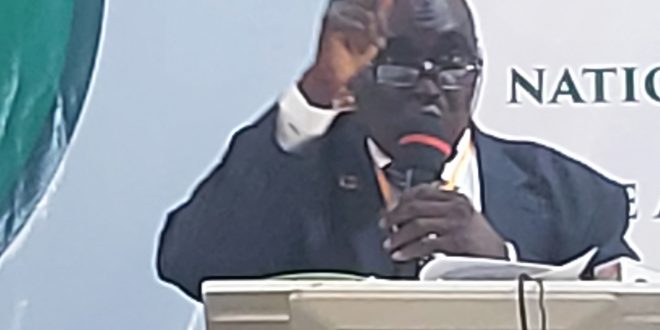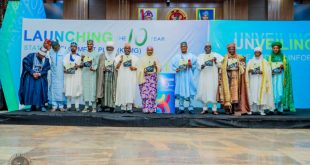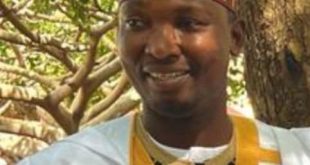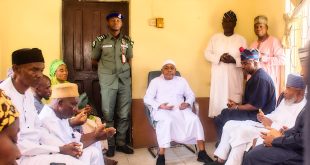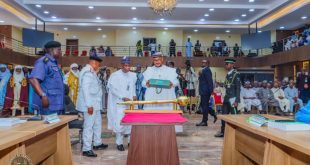Being a Keynote Address by Barrister Aliyu Ishaq Lolo, Legal Adviser, Office of the Senior Special Assistant to the President on Sustainable Development Goals (OSSAP-SDGs), at the inauguration of the National and State Executives of the Zabarkano Association of Nigeria held on Saturday, 21st January, 2023, at the Radio House Conference Hall, Area 11, Garki, Abuja – Nigeria.
Protocols
▪ Distinguished ladies and gentlemen.
▪ Please, permit me to stand on the well-established protocol for this
Occasion.
1.1 Preamble
“He who forgets his past cannot understand his present”
– Songhay proverb
“All true passes through three stages…First, it is ridiculed; secondly,
it is violently opposed. Third, it is accepted as being self-evident.”
– Arthur Schopenhauer
There is very little that is more important for any people to know than their history, culture, traditions and language; for without such knowledge, one remains naked, and defenseless before the world.”
– Marcus Tillus Cecero (106 -43BC)
1.2 Preliminaries
It gives me great pleasure to be here today at the inauguration of the National and State Executives of the Zabarkano Association of Nigeria beautifully put together by the high-powered organizing committee of the Association.
I have been asked to give the Keynote
address – not because I am the best qualified to do so, as there are
senior Nigerian citizens of Zarma extraction with far wider experience and shoulders to carry the load and whom the job could have been better suited, but because the elders want their young to also grow, they decided to assign the responsibility to me. A privilege I never intend to either abuse or misuse. Hence, the acceptance of the
clarion call.
It is, therefore, my singular honor, to stand before this August gathering in January, to deliver this address.
I do this with every sense of humility and respect to both my elders in attendance and those that would have loved to be physically here but unavoidable
absent but very much around in spirit or on representative capacity. I greet you one and I greet you all! For those that may be hearing about the tribe called Zarma/Zabarmawa or an association called Zabarkano Association
of Nigeria for the first time, take your calm. We have some literature here with us that answer some of the curious questions you may have about them.
Others may be answered in the course of this brief keynote address – copies of which may also have been available to
those in attendance by now while large volume of literature can be
accessed on the web.
1.3 Introduction
It is something of common knowledge that before the advent of colonial masters after their exploratory and missionary activities in the landmass now known as West Africa and, indeed Africa as a whole in the 19th Century, people lived in cluster of communities like hamlets, villages and city states governed by dynasties, empires, caliphates or kingdoms several hundred years earlier.
Incidentally, a good number of those dynasties, empires and kingdoms were either solely founded and ruled by the Zarma/Zabarmawa people or
jointly with other tribes (like the Sokoto Caliphate, for instance).
The smaller settlements or communities were formed by people, mostly
of the same tribal or family background, who must have decided to settle there for the purpose of farming, rearing of their livestock, hunting and fishing or yet still for securing themselves from attacks from other communities who looked for better places to conquer in the bid to expand their territorial relevance or on their slave capturing expeditions.
With the coming of the colonial masters and the scramble for and partition of Africa by the seven Western European powers between 1881 and 1914 at the Berlin Conference of 1884, these communities
and empires were scattered and divided among those super powers for the purpose of administering those areas and extracting their vast natural resources and raw materials to feed their emerging industries
after the industrial revolution was engendered by the invention of
the internal convulsion engine.
This led to the eventual dismantling of the older dynastic, empire, caliphates or kingdom systems and the emergence of the imperial system of administration.
Some of the acquired territories were ruled through the direct rule system
(French colonies) while others, through the indirect rule system
(British colonies).
By the year 1914, almost all territories, particularly in what is today
referred to as Nigeria, have fell to the rule of the colonial masters under two broad Protectorates – Southern and Northern Protectorates. Sokoto Caliphate, for instance, fell in 1906 and Lord Fredrick John Dealtry Lugard, the then Governor General that wasin charge of the two Protectorates decided to merge or amalgamate them. In 1914, they were amalgamated to form “Niger Area” which, with the passage of time, became a singular noun, Nigeria.
1.4 The Indigenous Zarma/Zabarmawa people of Nigeria Ever since the amalgamation of Southern and Northern Protectorates and the birth of Nigeria as mentioned above when imaginary/invisible borderlines were drawn by the colonial masters, communities that were hitherto living together as one, sharing the
same historical, cultural, tribal and linguistic backgrounds became
brutally divided and separated bearing different citizenships.
Those that belong within the British territory of Nigeria are referred to as Nigerians and those that fell on the other divides bear the citizenship of those territories in which they found themselves, alas by chance and providence.
In some instances, members of the same family, living in same compound, became separated by the imaginary borderlines never again to see themselves as compatriots.
It is the above circumstances that made some tribes to be sometimes
found in both ends of the divides. That is why, for instance, it is not uncommon to find Yoruba speaking people in Nigeria and Benin Republic around the Badagry and Seme borders; Kanuri and Shuwa Arabs in Niger, Chad, Cameroun and Nigeria in those areas where
they are close neighbors.
The same applies to Hausa speaking people found in Niger, Nigeria, Chad and Cameroun just as Fulani are also
found all across those territories.
There are tribes in the South-Eastern Nigeria that are also indigenous to Cameroun. The situation
is the same with the Zarma/Zabarmawa who are found in large numbers in border communities in Benin, Niger, Nigeria, Burkina Faso, Togo, Mali, Chad, Cameroun, etc in addition to other countries such as Sudan and Saudi Arabia etc. This should not be surprising if the other instances mentioned in case of other tribes is not.
2.1 Who are the Zarma/Zabarmawa as a people?
The Zarma are from Prophet Adamu (Adam) and his wife Hauwa’u
(Eve).
Their linage, therefore, can be traced back to the two (Q. 4:1)
Through Adam and Eve, as we may be aware, all generations of mankind emerged. The first children of Adam and Eve were Cain and Abel.
When they were of marriageable age, Adam broke the news of how they were to be cross-married – twin sister of one to
marry the twin brother of the other. Cain was not happy because he preferred his twin sister as she was more beautiful than that of Abel who was said to be black with roundish face and two protruding upper incisors that could barely be covered by her lips.
As a result,he promised to slay Abel if the arrangement was executed. He carried
out his threat.
After this incident, Adam and Eve gave birth to another male child
called Seth (Shitu) who himself was a Prophet.
The relevance of this story is that, the Zarma origin can be traced to this noble prophet of Allah down to the time of Prophet Muhammad (SAW) and even to
modern times.
From Seth (Shitu), the linkage goes thus: Qinan, Mahla’al, Aayarid, Idris (Enoch), Mutalssalkh, Lamik, Nuhu (Noah), Samu (Shem), Arfakhsad, Shalikh, Abir, Falikh, Ra’u, Saru’, Nahur, Azar, Ibrahim (Abraham), Isma’il (Ishmael), Haidir, Aram, ‘Adwa, Wazzi, Sami, Zarih, Nahith, Muksar, Aiham, Afnad, Aisar, Desham, Aid, Ar’awi, Yalhan, Yahzin, Yathrabi, Sambir, Hamdan, Ad-Da’a, ‘Ubaid,
‘Abqar, Aid, Makhi, Nasih, Jahim, Tabikh, Yadlaf, Bildas, Haza, Nashid, Awwam, Obai, Qamwai, Buz, Aws, Salaman, Humaisi’,
Add, Adnan, Ma’ad, Nizar, Mudar, Elias Mu’drikah, Khuzaiman, Kinana, An-Nadr, Malik, Fahr, where Zibirkan’s linage is said to have converged with the Prophet (SAW).
Zibrikan (Zabarkano) belongs to the Banu Tamim from an area believed to be present day Riyadh – Saudi Capital and he is believed to be the Patriarchal great grandfather of the Zarma/Zabarmawa people.
(On this, see my paper titled “Abridged History of Zarma Progeny from Ancient, Medieval to the Modern Times, being a paper presented at ZADA/Zabarkano Association 100 million Naira Fundraiser held on 28th August, 2022, at Birnin Kebbi Stadium, Birnin Kebbi, Kebbi State at pp. 14-18).
2.2. The linkage of Zibirkan (Zabarkano) with modern Zarma/Zabarmawa in Nigeria
Now the vexed question: How can people whose origin could be traced back this far, claim to belong to where they live today? The answer is the same with every other tribe found in any location in the world – except perhaps those that may have sprouted from the ground or that were given birth to by the rocks and trees in their localities and I doubt if there are any such people.
The truth of the matter is that, all human beings can be traced back to Adam and Eve (Q. 4:1). It is through human reproduction either by way of marriage or other traditional means of procreation that
human beings became multiplied and spread all over the place through migratory activities some predating others in their present-day settlements. Therefore, people claiming to be more indigenous
in a locality through ancestry today, may actually be descendants of the subjects of other people’s ancestors some years back.
2.3. Emergence of Zarma/Zabarmawa language from Arabic and
Songhoy Since we mentioned Zibirkan, who was an Arab, to be the Patriarchal
great grandfather of the Zarma, there is need to link his history to the
Matriarchal great grandmother of the Zarma which is traceable to
Malle (where the Zaria ruling class of Mallawa must also have, perhaps, originated from).
This great Dynasty was referred to as Gao
and Songhoy, who ruled over the land of the Gorongobou or Gorongobou-Laabu which, according to Prof. Hassimi Oumarou Maiga (2009) was a Dynasty that existed for about two thousand five
hundred years (2,500 years) and was incidentally ruled by the Zarma/Zabarmawa spanning back to the times of the Pharaohs of
Egypt.
This massive historic dynasty covered the whole landmass described
today as West, North and part of Central Africa ruled by the Zarma/Zabarmawa – which is the generic term to include the
Songhay (one of whose commanders was the Kanta of Argungu) and the Dendi through the Bentyia (koukya) Dynasty whose territorial coverage ran from Adagh in modern Algeria to the Niger and along the Niger Valley from Gao to Bussa in Nigerian Borgu and beyond
(Paulo Fernando de Moraes Farias, April, 2013).
This ancient Zarma/Songhoy/Dendi Bentyia (Koukya) Dynasty with its headquarters in Kandi (in present day Benin Republic) which,
according Prof. Hassimi Oumarou Maiga (2009) was ruled over by
the Koungorogossi whose history dates back to 270AD to 764AD spanning from Koungorogossi Gariko Mallenke Songhay to the last king Imran Naaki-Songhay.
(For the names and period of rule of all
the leaders that ruled that dynasty between the above two leaders,
see Aliyu Lolo, 2022).
2.4 How Zarma/Songhoy/Dendi languages emerged from the same source Zibirkan’s son, Abdullahi ibn Zibirkan was said to have migrated from Egypt towards the west after the defeat of the Byzantines by the Muslim Army under the command of a Zarma/Arab military Commander, Qa’qa bin Tamim Al-Qari’ (Aliyu Lolo, August, 2022).
He arrived in Malle or Timbuktu (Gao) in present day Mali along with his son, Maliki Aramarama who was said to have married a lady from the Songhoy (who ruled over that land since the middle of the 3rd Century AD) had a child called Zar, who also married and had Zarmalle who had Abdu Dausana and Zarmakoi Sambo who some informants said flew the thatch-mat along with his people to a place called Koobi or Sargan leaving behind his brother Abdu Dausana.
At Sargan Zarmakoy Sambo married from among the Anzuru/Zarma-
Ganda people where he had a child called Mali Bero and many other
children. It was Mali Bero that was the most popular of all the children and whom some other informants said flew the thatch-mat to Sargan. He also had three children: Zarmakoy Tabu, Abubakar
and Gashiya.
It was at this stage that the Arabic language that Zarma spoke gradually gave way for Zarma language as it is spoken today in different dialects – Zarma, Songhoy and Dendi (Aliyu Lolo,
August, 2022).
3.1 Zarma/Zabarmawa and the Kabawa of Argungu On the other hand, the Kabawa too, according to Abdulbasir Ahmad
Atuwo and Umar Aliyu Bunza (December, 2014), are said to be somewhat part of the former Songhoy (Songhay) Empire under the Muhammadu Toure Albakari, popularly known as Askia Muhammad the Great (1493-1591 AD). In fact, according to the above authors, it is said that Kabi was a district under the vast Songhay
Empire that extended to the remnants of former Mali Empire such as
Taghaza, Agades, Katsina, Zamfara and Kano all of which were being overseen by Muhammad Kanta.
In an attempt to know the origin of the second word Kanta in Muhammadu’s name among the Shongai and Kabawa ethnic groups, Aliyu Muhammadu Bunza (December, 2014) concluded that there
was no ascertainable meaning attached to the word. However, there are opinions that the word emanated from what was attributed to Muhammad Kanta, the founder of Kabawa Dynasty who, according to Atuwo and Bunza (December, 2014), later broke out of Songhay
Empire around 1516 AD with its capital in Surame on issues around the sharing of war booties. Muhammadu used the word “kata” whenever he wanted to ask his royal guards to bring something to him.
The word “kata” – means “bring it” in Zarma-Songhai language
which was later corrupted to “kanta”. This lends some credence to the belief, in some quarters, that Muhammadu Kanta might be asking his guards to bring a mysterious cow before him, which in turn, made
some to think that the word Kanta was used as a noun to describe the
cow rather than a verb asking the cow to be brought.
Whatever the true meaning of Kanta is, Muhammadu Kanta, the bearer of the name certainly, may have shared some common political and or linguistic origins with the Zarma-Songhoy which is cherished and re cognized by the Kabawa ruling class till today.
Muhammadu Kanta moved his capital from Surame to Kabi in 1721 due to incessant attacks from Gobir and Azbinawa.
The Jihad of Shehu Usmanu Danfodiyo broke out in 1804 in which the indigenous Zarma/Zabarmawa of Birnin Bonkano in present day Sokoto State played very vital role and this was when Shehu’s brother Abdullahi of Gwandu chased away the Kabawa in 1805 and
river’s great bend and its confluence with Benue at Lokoja).
Banizumbu, one of the Dendi towns is now headed by a Zarma/Zabarmawa District Head, Alhaji Dauda Haruna Noma who
is to deliver a goodwill message at this occasion).
In fact, it is believed
by Dr. Mansur Abubakar Wara (2019) that the Hausa word of Sarkawa evolved from the Zarma/Zabarmawa word of Sorko who
are masters of the river and were community leaders who led over
Al-kawkaw several years ago.
3.3 Zarma/Zabarmawa in Yauri and Borgu areas
The exact time Zarma/Zabarmawa arrived into the places known today as Yauri and Borgu is not very well known as at yet. However, some studies indicated that the Zarma/Zabarmawa were not the first
to have stepped in their foot into the areas, although Borgu is said to have originated from the five Zarma Commanders from Songhay empire who rode on five horses (Bari gu) and took occupation of that
territory as early as the first half of the 15th century, the Gungawa settlements on some islands on the River Niger in the Yauri and Borgu area had received some Hausa traders, some of whom even settled among the Gungawa people.
Those Hausa migrant traders were believed to have established their hegemony by peaceful means over the Gungawa and later used force and brought the Kambari people on the mainland under their control. By the end of the 15th century the Kambari in the Maginga area had also come under the rule of the Hausa people.
According to Bunza, it was the Hausa
people who established their political rule over the Awunci Kambari
and Gungawa of Yauri and Maginga area, controlling them to date.
4.1 The aims and objectives behind the formation of Zarma/Zabarmawa Associations
The aims and objectives behind the Zarma/Zabarmawa associations
is basically to create more awareness among their members and non-
members alike about the need for peaceful co-existence, tolerance, industry and productivity on one hand and the need to promote unity, progress and development of their members and the environments in which they find themselves on the other and to also preserve the rich Zarma/Zabarmawa socio-cultural, educational,
religious and linguistic values from extinction with the ultimate
mission and vision of making their motherland, Nigeria one of the
greatest nation states in human history.
Before now, there was the belief in some quarters that among all languages spoken in Nigeria, it is only Zarma/Zabarmawa language that is looked at with scorn and suspicion.
This stereotype is mostly observed to be attributable to the attitude of some Zarma/Zabarmawa themselves towards their language.
They never cared to use the language in public places as their medium of communication either due to some complex or for some reasons best known to them.
However, it may also be attributable to the reserved nature of Zarma/Zabarmawa as a people who, before now, never agreed to detach themselves from the traditional belief of not integrating themselves into new systems.
A few agreed to attend western system of education.
Those that cared to, feel more attached
to westernization than to preserve their cultural and linguistic identity.
This has created fertile ground for some semi-literate members of the Nigerian Immigration Service to embark on incessant attack, persecution and humiliation of innocent and gullible
Zarma/Zabarmawa people most of whom themselves, are hardly educated in western education.
The cause of concern is that, some of the not too informed Zarma/Zabarmawa have, in the past, indicated preference for the
use of Hausa language on theirs, since in their belief, the former is adjudged one of the three major Nigerian languages attributed to everyone of Northern Nigeria extraction, speaker of which, no matter where the person originates from entitles him/her to an automatic Nigerian citizenship no matter where he comes from. He also seems to command more respect in the eyes of other people who classify everyone from the North as Hausa/Fulani – more unfortunately so, even in case of some un-informed immigration officers who know virtually nothing about the history and sociology of the Zarma in the
North and who kept harassing the Zarma/Zabarmawa people of low
class and knowledge (no matter whether they are Nigerians or not) and compelling them to admit being foreigners by brute force whenever they cross ways.
The above unfortunate attitude makes the Zarma/Zabarmawa language and identity endangered in some parts of Nigeria because those that try to preserve and speak the language in public places are,
sometimes, looked at with disdain. However, there is good news.
Ever since the conception of Zabarkano Association about three (3)
decades ago, people have shown significant interest in understanding who the Zarma/Zabarmawa are and the desire to know more about them and the number of Zarma/Zabarmawa and non-Zarma speaking people that are willing to learn the language has grown progressively. In fact, this speaker alone can, with every sense of humility and modesty boast of authoring about six (6) different
books in Zarma/Zabarmawa language. Some are poetry books while
others are novels or fiction books.
Some of them are:
1. Gabu ga hai Kwalgwai, Culubela ga hai Tokka Moocirai
2. Watunkai iri ma Himma dan
3. Maise Kai ka Hanganai se
4. Garfulle Min Nyewu
5. Kwanya Nya Fuwo Ton, Wa Gaasai Kumba-Kumba
6. Buttugau Si Hai Ka Hatta
While the first three books are poetry and phonology books containing themes on cultural antics and values, the last three are novels or fiction with full blend of Zarma grammar with sociological
and anthropological connotations. All the six books have been completed and are just awaiting more editing before final
publication.
This is in addition to the author’s participation in international television programs such as “Zagu Banda Ka Jine Fonnai” which is shown on some international television stations every
fortnightly.
The author also participates in the editing of the translation of the Holy Qur’an into Zarma/Zabarma language being
carried out by some patriotic Zarma/Zabarmawa scholars as well as
other areas of developing the language.
The attitude of Zarma to his language from within and the external factors from other tribes and languages that threaten the identity of the tribe and its rich cultural, educational and political background, is what prompted the author and some concerned members of Zarma clan to start the process of registering the first indigenous National
Zarma Association named Zabarkano Bonkano Association of Nigeria which got formally registered by the Corporate Affairs Commission (CAC) about 17 years ago and from which other Zarma Associations such as ACI Gaabero Foundation, Zabarmawa
Association of Kebbi State in addition to so many Zarma Students Associations scattered in many campuses of our Nigerian institutions of higher learning emerged.
5.1 Sincere advice to the new Executives of the AssociationToday, we are witnessing the inauguration of the National and State Executives of Zabarkano Association of Nigeria, the mother of all Zarma/Zabarmawa Associations in the country. My call on those that are to be sworn in is that, they should remember that they are to be leaders and not rulers and whoever is to lead, should lead by example and fear of and respect for the divine laws of his creator – Allah.
They should always remember the Hadith of the Noble Prophet Muhammad (SAW) which says:“Kullukum Raa’in, wa Kullukum Mas’ulun an Ra’iatihi”, which means, “All of you are pastoralists over your subjects and all of you will be put to question on the responsibilities you are entrusted with”.
Lastly, we should remember that leadership of an association is not
hereditary or arbitrary. On this note, they should work tirelessly to build bridges and give all members a sense of belonging.
All hands must be on deck to ensure the achievement of the common goal of
our people which is peace, unity, love and patriotism in addition to all other good qualities collectively geared towards the preservation of our rich ancestral core values leading to the ultimate development of our people and nation.
Therefore, whoever is found wanting by placing his personal interest over and above these good objectives, may be sanctioned as appropriate either by removal or by surrendering him to the appropriate quarters for the disciplinary
actions prescribed by law for his type of breach.
That is not our wish
anyhow.
Conclusion
From the brief history of the Zarma/Zabarmawa, it could be
observed that they are from descent historic background and are highly industrious and portray some qualities of good leadership and followership which are basic ingredients of human
development.
Like all other tribes found in border towns of Nigeria and its neighboring states and are indigenous in both,
Zarma/Zabarmawa are also found in Nigeria and other neighboring
nations and indigenous to both places.
It could also be observed that Zarma/Zabarmawa have always been
part of the political and geographical entity known and called West Africa in general and Nigeria in particular.
They ruled over territories spanning from Egypt in North Africa to Nigeria, Sudan
and Cameroun during dynasties and empires that lasted over 2500 years before any of those nations were born.
Thank you,
God bless Zabarkano Association of Nigeria in particular and
Federal Republic of Nigeria in general. Amin
 THESHIELD Garkuwa
THESHIELD Garkuwa
